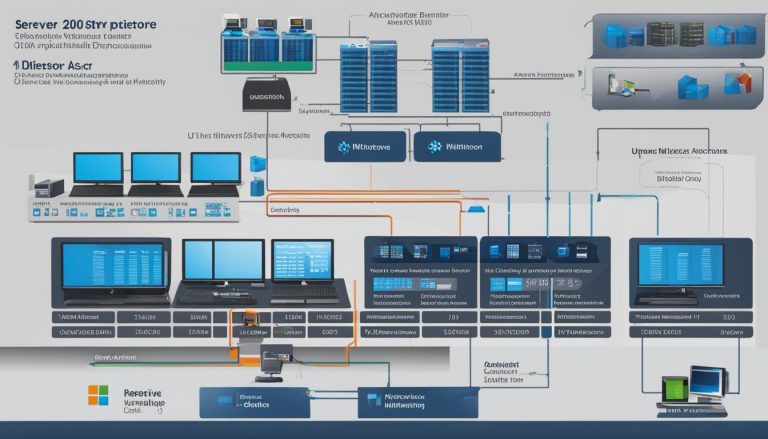Are you curious about the powerful server platform that revolutionized the operating system market back in 1993? Look no further than Windows NT 3.1 Advanced Server, a version of the popular Microsoft Windows operating system designed specifically for businesses. With its scalable architecture, multitasking capabilities, and improved network features, Windows NT 3.1 Advanced Server provided a reliable and secure platform for running business applications and managing network resources.
To learn more about the history, key features, system requirements, installation process, and legacy of Windows NT 3.1 Advanced Server, continue reading this article.
Key Takeaways:
- Windows NT 3.1 Advanced Server was a groundbreaking server operating system released by Microsoft in 1993.
- It offered advanced features, improved networking capabilities, and enhanced security measures.
- Windows NT 3.1 Advanced Server set new standards for server operating systems.
- It laid the foundation for future versions of Windows Server.
- Windows NT 3.1 Advanced Server provided a robust and secure platform for businesses to manage their network resources.
The History of Windows NT 3.1 Advanced Server
Windows NT 3.1 Advanced Server, released by Microsoft in July 1993, was a significant milestone in the development of server operating systems. It was an advanced version of Windows NT 3.1 and introduced several new features and improvements over its predecessor.
The release of Windows NT 3.1 Advanced Server marked the expansion of Microsoft’s server offerings, providing enhanced networking capabilities, support for multiple CPUs, and improved security features. This version of Windows NT laid the foundation for future releases of Windows Server, showcasing Microsoft’s commitment to delivering scalable, reliable, and secure server platforms.
The evolution of Windows NT 3.1 Advanced Server continued with subsequent versions, each building upon the advancements made in previous releases. Windows NT 3.1 Advanced Server set the stage for Microsoft to establish its dominance in the server operating system market, delivering innovative solutions to meet the evolving needs of businesses.
| Windows NT 3.1 Advanced Server Release Date | Windows NT 3.1 Advanced Server Versions |
|---|---|
| July 1993 | Windows NT 3.1 Advanced Server |
With the release of Windows NT 3.1 Advanced Server, Microsoft made a bold statement in the server operating system space. Its history serves as a testament to the company’s ongoing commitment to innovation and excellence in providing powerful and reliable server platforms.
Key Points:
- Windows NT 3.1 Advanced Server was released in July 1993.
- It introduced enhanced networking capabilities, support for multiple CPUs, and improved security features.
- Windows NT 3.1 Advanced Server laid the foundation for future versions of Windows Server.
Key Features of Windows NT 3.1 Advanced Server
Windows NT 3.1 Advanced Server offered a range of key features that made it an attractive choice for businesses. Let’s take a closer look at some of its notable features:
Scalable Networking
Windows NT 3.1 Advanced Server had improved networking capabilities, allowing businesses to set up large-scale networks efficiently. It offered reliable and high-performance networking services, ensuring seamless communication between servers, clients, and network devices.
Support for Multiple CPUs
Another standout feature of Windows NT 3.1 Advanced Server was its ability to handle multiple CPUs. This meant that businesses could take advantage of the server’s scalability and run resource-intensive applications without experiencing performance bottlenecks.
Advanced File and Print Services
Windows NT 3.1 Advanced Server provided robust file and print services, allowing businesses to efficiently manage and share files and printers across the network. It offered features such as file-level security, remote printing, and centralized administration, enhancing productivity and streamlining workflow.
Enhanced Security Measures
Security was a top priority for Windows NT 3.1 Advanced Server. It introduced advanced security measures, including user authentication, access control, and auditing capabilities. These features ensured that business data and resources were protected from unauthorized access and maintained the integrity of the server environment.
These features, along with others, made Windows NT 3.1 Advanced Server a reliable and efficient platform for businesses. It provided the necessary tools and functionalities to manage network resources, deliver reliable performance, and maintain a secure server environment.
System Requirements for Windows NT 3.1 Advanced Server
Before installing Windows NT 3.1 Advanced Server, it is important to ensure that your system meets the necessary requirements. The following are the minimum hardware specifications needed to run the server operating system:
- Processor: 386 or higher
- Memory: 12 MB of RAM
- Hard Disk Space: 90 MB of free disk space
- Display: VGA or higher-resolution display
In addition to these requirements, you will also need a CD-ROM drive for installation and a network adapter for networking capabilities. It is worth noting that these are the minimum requirements, and it is recommended to have more powerful hardware to fully utilize the advanced features of Windows NT 3.1 Advanced Server.
If you’re unsure about your system’s compatibility or need assistance with meeting the requirements, it is advisable to consult the official documentation or contact Microsoft support for guidance.
| Minimum System Requirements | |
|---|---|
| Processor | 386 or higher |
| Memory | 12 MB of RAM |
| Hard Disk Space | 90 MB of free disk space |
| Display | VGA or higher-resolution display |
| Additional Requirements | |
| CD-ROM Drive | For installation |
| Network Adapter | For networking capabilities |
Installation and Documentation of Windows NT 3.1 Advanced Server
Installing Windows NT 3.1 Advanced Server is a straightforward process that requires following a step-by-step setup guide provided by Microsoft. The official documentation gives detailed instructions on configuring the system and setting up various server roles.
To begin the installation, you need to create installation disks or use a CD-ROM. Once the installation media is ready, boot from it and follow the prompts to configure your system. The setup guide will walk you through important choices such as selecting the installation type, partitioning the hard drive, and specifying regional settings.
After the initial setup, the documentation provides guidance on post-installation tasks, including creating user accounts, setting up network services, and configuring security settings. The documentation also covers advanced topics such as network configuration and troubleshooting common issues that may arise during the installation process.
| Windows NT 3.1 Advanced Server Installation Steps |
|---|
| 1. Create installation disks or use a CD-ROM. |
| 2. Boot from the installation media. |
| 3. Follow the prompts to configure the system. |
| 4. Select the installation type and partition the hard drive. |
| 5. Specify regional settings and other preferences. |
| 6. Complete the initial setup. |
| 7. Create user accounts and set up network services. |
| 8. Configure security settings and troubleshoot any issues. |
“The installation process of Windows NT 3.1 Advanced Server is well-documented, making it easy for administrators to set up the server operating system. Following the step-by-step guide ensures a smooth installation and configuration process.”
Windows NT 3.1 Advanced Server: Legacy and Impact
Windows NT 3.1 Advanced Server had a profound impact on the server operating system market, leaving a lasting legacy that can still be seen today. Its advanced features, improved networking capabilities, and enhanced security measures set new standards for server operating systems, shaping the future development of Microsoft Windows.
One of the key legacies of Windows NT 3.1 Advanced Server is its scalability. It introduced the ability to handle multiple CPUs and large amounts of memory, paving the way for high-performance server environments. This scalability became a fundamental requirement for businesses as their computing needs grew, and subsequent versions of Windows Server continued to build upon this foundation.
Another lasting impact of Windows NT 3.1 Advanced Server is its emphasis on reliability and security. It introduced robust file and print services, advanced security measures, and a secure development environment. These features elevated the server operating system’s reputation as a trustworthy platform for businesses to manage their network resources.
The influence of Windows NT 3.1 Advanced Server can be seen in the development of subsequent Windows Server versions. Each release built upon the advancements made in Windows NT 3.1 Advanced Server, incorporating new technologies, improved performance, and enhanced security. Today, the modern server infrastructure owes much of its foundation to the groundbreaking innovations introduced by Windows NT 3.1 Advanced Server.
Table: Key Contributions of Windows NT 3.1 Advanced Server
| Legacy | Impact |
|---|---|
| Scalability to handle multiple CPUs and large memory | Enabled high-performance server environments |
| Robust file and print services | Improved network resource management |
| Advanced security measures | Enhanced server security |
| Secure development environment | Reliable platform for server applications |
Conclusion
Windows NT 3.1 Advanced Server was a groundbreaking server operating system released by Microsoft in 1993. It offered advanced features, improved networking capabilities, and enhanced security measures, making it an ideal choice for businesses. With its legacy and impact on the server operating system market, Windows NT 3.1 Advanced Server laid the foundation for future versions of Windows Server and paved the way for the modern server infrastructure we have today.
Whether being used for file and print services, database management, or hosting web applications, Windows NT 3.1 Advanced Server provided a robust and secure platform for businesses to manage their network resources. Its scalable architecture and support for multitasking allowed businesses to efficiently handle multiple tasks and users, while its improved network capabilities enabled seamless communication and collaboration.
Windows NT 3.1 Advanced Server set new standards for server operating systems with its reliability and security measures. It introduced features like advanced file and print services and implemented improved security measures to protect sensitive business data. These advancements laid the groundwork for the development of subsequent versions of Windows Server, which further expanded upon the capabilities introduced by Windows NT 3.1 Advanced Server.
FAQ
What is Windows NT 3.1 Advanced Server?
Windows NT 3.1 Advanced Server is a version of the Microsoft Windows operating system that was released in 1993. It served as a powerful server platform for businesses, providing advanced features and improved network capabilities.
When was Windows NT 3.1 Advanced Server released?
Windows NT 3.1 Advanced Server was released by Microsoft in July 1993.
What are the key features of Windows NT 3.1 Advanced Server?
Windows NT 3.1 Advanced Server offered features such as large-scale networking support, scalability for multiple CPUs and large memory, advanced file and print services, and improved security measures.
What are the system requirements for Windows NT 3.1 Advanced Server?
The minimum system requirements for Windows NT 3.1 Advanced Server include a 386 or higher processor, 12 MB of RAM, 90 MB of free hard disk space, and a VGA or higher-resolution display. Additional requirements include a CD-ROM drive and a network adapter for networking capabilities.
How do I install and set up Windows NT 3.1 Advanced Server?
To install Windows NT 3.1 Advanced Server, you need to follow the step-by-step process outlined in the official Microsoft documentation. This involves creating installation disks or using a CD-ROM, booting from the installation media, and following the prompts to configure the system. The documentation provides detailed instructions on setting up and configuring server roles, managing users and permissions, and troubleshooting common issues.
What is the legacy and impact of Windows NT 3.1 Advanced Server?
Windows NT 3.1 Advanced Server had a significant impact on the server operating system market and the overall development of Microsoft Windows. It introduced cutting-edge features and technologies that laid the foundation for future versions of Windows Server. The scalability, reliability, and security capabilities of Windows NT 3.1 Advanced Server set new standards for server operating systems.
Janina is a senior specialist in information technology


